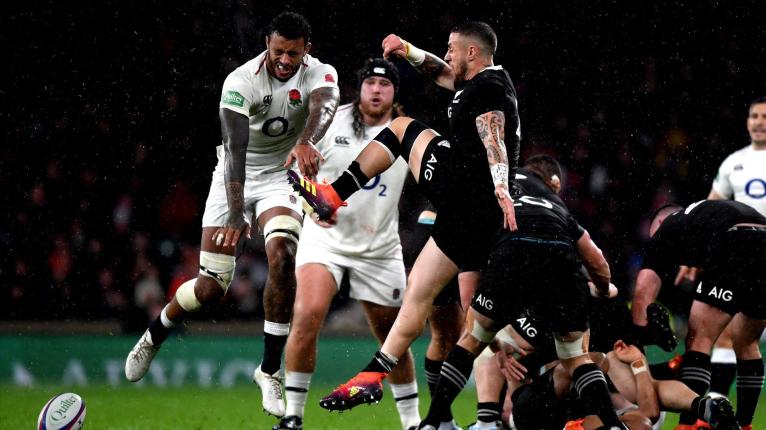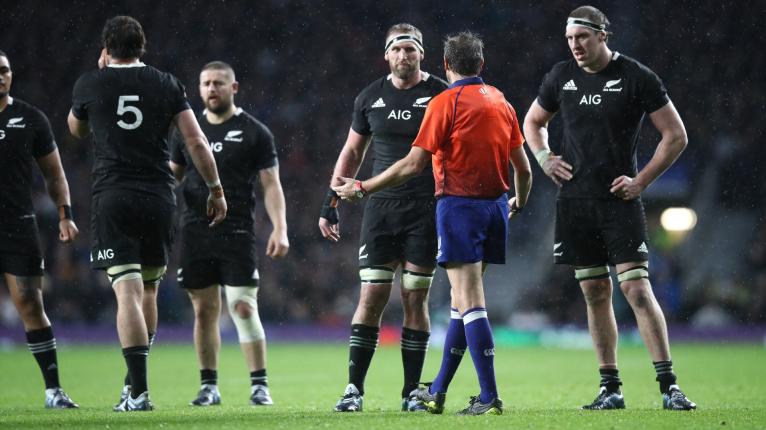What rugby union can't admit to itself about TMOs and how the last two weekends proved it

Eleven-plus probability and elite-level test match rugby are unlikely bedfellows.
But for those gripped by the denouement of England’s truly thunderous test matches against South Africa and New Zealand, they became intrinsically linked.
The thing about a 50/50 call – even for us non-mathematicians – is that the eventual outcome is equally likely to go in either direction.
And over the course of two Twickenham Saturdays, that is exactly what happened to Eddie Jones’s team.
When the TMO was consulted on Owen Farrell’s overtime tackle on Andre Esterhuizen, he decreed that England’s flyhalf had made at least some attempt to wrap his arms around the South African. This rendered it legal and secured a one-point win for the hosts rather than the two-point defeat that a penalty award would probably have delivered.
Continue reading below…
Eddie Jones reacts after England loss to the All Blacks
Seven days on, the man in the TV van decided Courtney Lawes was offside prior to making the 75th minute charge-down from which Sam Underhill claimed a ‘try’ which would have put England a score ahead of the All Blacks. As a consequence, England lost by the same one-point margin.
Inevitably, criticism of the match officials has followed both decisions, since another feature of a 50/50 call is that half us disagree with the outcome. And since Jerome Garces’ coin fell against England at Twickenham, there is no prize for guessing how the British media typically viewed the Lawes decision.
One regular feature of this criticism is that the presence of the TMO should eradicate all errors. Put another way, these commentators believe hindsight, for the man in the TV van, should be an exact science.
But surely the use of technology over many years has taught us differently. While the introduction of the TMO, third umpire or video ref has largely eradicated the complete ‘howler,’ in less clear-cut situations it often shifts rather than resolves the debate.

So while Andy Haden’s match-clinching dive out of a lineout at Cardiff in the late 70’s would now result in a yellow card for gamesmanship and a penalty to Wales, we are still unclear whether Mark Cueto scored in the 2007 World Cup final.
To draw a parallel with cricket – where technology works with huge success – consider a situation where the umpire is unsure if a ball pitched outside leg stump in assessing an lbw appeal.
The TV company shades the stump-to-stump area on the screen, but the ball pitches on the edge of it. A zoomed-in view then shows the seam of the ball to be exactly down the virtual line drawn on the outside of leg stump. Is 51 per cent of the ball in the shaded area or outside it? Technology has not removed the debate, it has simply changed it.
Throw rugby union’s complex laws into the mix and this search for certainty becomes even more futile. Good refereeing, especially at the higher levels of the game, is much more about communication and management than minutely scrutinising a match for law infractions.
And this is possibly why the use of the TMO for 50/50 calls such as these does not sit well with many. When Jerome Garces asked Marius Jonker to take a look at the Lawes charge-down, he introduced – for the only time in 80 minutes – slide-rule accuracy to the decision-making process.

Was it a ruck or a tackle? Where was the offside line for non-participants? Did this line move before the ruck was over? Was the player at the front of the ruck (who creates the offside line) bound into it? When did the ruck end – as the ball emerged or when the scrum half lifted it?
There are so many law questions relevant to this decision, that making them with 100 per cent accuracy in real time is impossible. Critics point out that this was also the case at every other breakdown throughout the match, but given the pivotal nature of this particular call, surely Mr Garces had every right to seek assistance?
A number of highly-respected journalists, including the two biggest names writing in the British broadsheets, strongly disagree with this opinion. They believe the referee should have gone with his gut instinct, backed his judgement and awarded a try, since there was no clear and obvious infringement.
However, which of us can honestly say we would not have used an available safety net at such a crucial moment? Why risk being proven wrong by a subsequent TV replay?
While continually seeking to review and improve the use of technology is entirely logical, our sport has to be very careful about how this is done. We have to move forward, develop and evolve, not take a backward step by reducing the referee’s ability to enhance his decision making.
As the same teacher who explained probability to me many moons ago liked to say, the toothpaste cannot go back into the tube.











































































